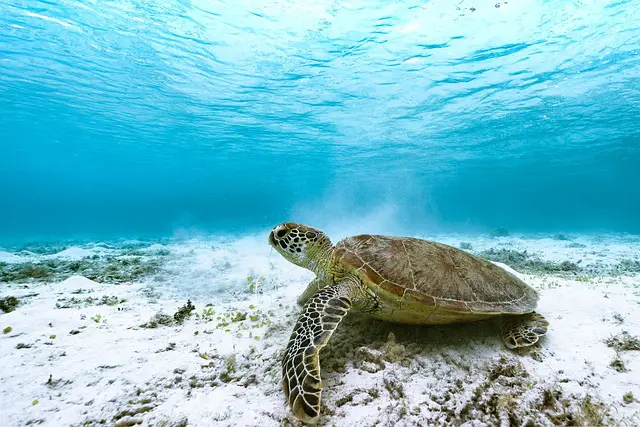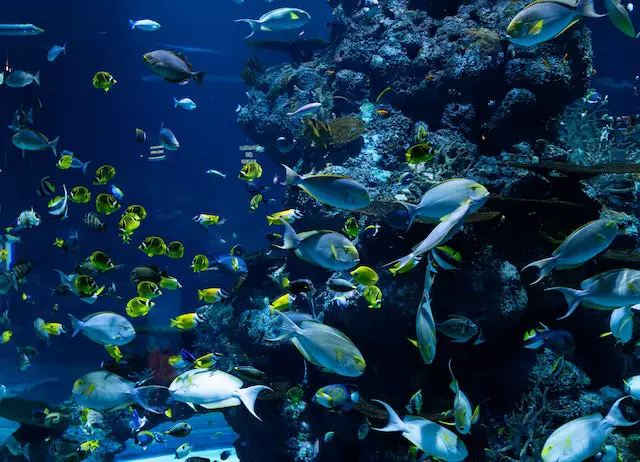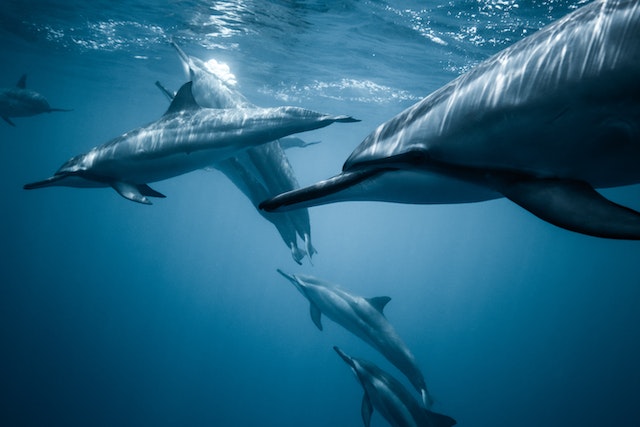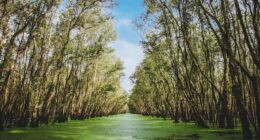Marine reserves focus on protecting specific areas and habitats, while marine parks offer broader conservation and recreational opportunities.
TL;DR Marine Reserves Vs. Marine Parks
Marine reserves are designated areas where human activities are restricted or prohibited entirely to allow for the recovery and regeneration of marine biodiversity. These areas serve as sanctuaries for fish, coral reefs, and other aquatic species to thrive without disturbance.
Marine parks encompass larger areas that not only protect marine life but also provide opportunities for sustainable human activities such as fishing, boating, and tourism. Marine parks aim to strike a balance between conservation efforts and socioeconomic benefits.
Marine Parks
Marine parks are designated areas in the ocean that are set aside for the protection, conservation, and sustainable use of marine resources. They are often established with the aim of preserving biodiversity, promoting tourism, and facilitating research and education.
Marine parks typically allow for a variety of activities such as fishing, boating, and recreational use, while still maintaining restrictions and regulations to ensure the protection of sensitive marine habitats.
Chankanaab Cozumel’s on of the best Marine parks that has a Dolphin Discovery program that provides fun and education for tourists while helping preserve biodiversity.
Marine Reserves
Marine reserves are areas within the ocean that are strictly protected from exploitation and human activity. They are established to conserve the marine environment and its biodiversity, allowing ecosystems to thrive undisturbed.
Marine reserves generally have stricter regulations compared to marine parks, prohibiting activities such as fishing, mining, and recreational use, with the primary focus being on conservation and ecological restoration.
The significance of Marine Parks
Ecological value: Marine parks play a pivotal role in preserving the biodiversity and ecological balance of our oceans. They serve as sanctuaries, offering essential shelter, breeding grounds, and feeding areas for a wide range of marine species.
By protecting these habitats, marine parks contribute to the overall health and well-being of ocean ecosystems.
Conservation efforts: Conservation initiatives and scientific research are integral to the functioning of marine parks. These efforts help us understand and monitor marine life, habitats, and the impacts of human activities.
By gaining knowledge through research, marine parks can implement better management strategies, including sustainable fishing practices and pollution reduction measures.
Economic benefits: Besides their ecological significance, marine parks also bring economic advantages to local communities. They support tourism by offering recreational activities such as diving, snorkeling, and wildlife watching.
These activities not only create employment opportunities but are also carried out in a sustainable manner, minimizing adverse impacts on the environment.
Education and awareness: Marine parks play an essential role in educating the public about marine ecosystems, conservation, and sustainable practices.
Through educational programs, interpretive centers, and guided tours, these parks promote environmental stewardship and raise awareness among visitors.
Collaboration and management: Effective management and collaboration are crucial for the success of marine parks. They require the involvement of government agencies, scientists, local communities, and conservation organizations.
Together, they address challenges such as overfishing, habitat destruction, and pollution to ensure the long-term viability of marine ecosystems.
Marine parks are fundamental in safeguarding marine habitats and species. They provide a means to protect and conserve the rich biodiversity present in our oceans, while also offering recreational, educational, and economic opportunities.
The significance of Marine Reserves

Conservation: Marine Reserves are sanctuaries for marine species, allowing them to thrive undisturbed.
By protecting critical habitats and reducing human impacts, they preserve biodiversity and maintain healthy ecosystems.
Fisheries Management: Marine Reserves support sustainable fisheries by acting as breeding grounds for fish and marine organisms.
They allow populations to replenish and spill over into adjacent areas, benefiting both fishermen and the overall health of the fishery.
Habitat Protection: Marine Reserves conserve important habitats like coral reefs, seagrass beds, and kelp forests.
These habitats provide essential nurseries, feeding grounds, and shelter for many species. Protecting them ensures the survival of countless marine organisms.
Scientific Research: Marine Reserves offer invaluable opportunities for scientific research and monitoring. They serve as natural laboratories for studying marine ecosystems and understanding the impacts of human activities on the ocean.
Climate Change Resilience: Marine Reserves enhance the resilience of marine ecosystems to climate change impacts.
By protecting habitats and preserving biodiversity, they contribute to the overall health and adaptability of marine ecosystems, which can better withstand challenges like rising temperatures and ocean acidification.
How Marine Reserves helped marine life revival
In 2003, the Great Barrier Reef Marine Park, one of the largest Marine Reserves in the world, played a crucial role in the recovery of Green Sea Turtles.
Prior to the establishment of the Marine Reserve, the population of these turtles was declining rapidly due to excessive hunting. After the introduction of fishing restrictions and habitat protection in the reserve, the population started to rebound.
Currently, the Green Sea Turtle population has more than doubled within the Marine Reserve, serving as evidence of the effectiveness of Marine Reserves in conserving and reviving marine species.
Detailed Comparison: Marine Parks vs. Marine Reserves
Definition and Purpose
Marine Parks
Definition: Marine parks are designated areas within coastal or marine environments that are managed to achieve a balance between conservation, recreation, and sustainable use of marine resources.
They may encompass diverse zones, including conservation areas, recreational areas, and zones for commercial activities.
Purpose: The main purpose of marine parks is to promote multiple uses of marine and coastal resources, ensuring the sustainable enjoyment of natural areas while conserving the environment.
These areas aim to facilitate recreational activities like swimming, snorkeling, boating, and fishing, while also supporting local economies through tourism and responsible resource utilization.
Marine Reserves
Definition: Marine reserves are specific areas within marine environments that are primarily established for conservation and protection.
They are designated as no-take zones or have strict restrictions on human activities to allow natural processes and ecosystems to function without significant human interference.
Purpose: The primary purpose of marine reserves is to protect and preserve marine biodiversity, habitats, and ecological processes.
By prohibiting or limiting extractive activities such as fishing, mining, and other forms of human exploitation, marine reserves provide a sanctuary for marine life to thrive, support healthy ecosystems, and aid in the recovery of depleted species.
Management and Regulations
To effectively manage and regulate these areas, the following key aspects should be considered:
Enforcement: Strict enforcement of rules and regulations is vital for effective management. This entails monitoring activities to prevent illegal fishing, pollution, and harmful practices.
Regular patrols and surveillance systems act as deterrents against illegal activities and ensure compliance.
Zoning and restrictions: Marine protected areas comprise different zones that offer varying levels of protection.
These zones include no-take areas where extractive activities are strictly forbidden and buffer zones that allow certain activities under specific conditions.
Clear zoning plans and appropriate restrictions help maintain a balance between conservation and sustainable use.
Permitting and licensing: In order to regulate human activities within marine protected areas, permits or licenses may be required. This ensures responsible conduct aligned with management objectives.
Permitting systems help manage and control the number of visitors or resource users to prevent overexploitation and minimize disturbance to the ecosystem.
Stakeholder engagement: Effective management involves engaging stakeholders, such as local communities, fishing communities, NGOs, and scientists. Collaborative approaches that incorporate local knowledge enhance the success of marine protected areas.
Research and monitoring: Regular research and monitoring programs are essential for evaluating management strategies and assessing the health of marine ecosystems. These programs measure biodiversity, water quality, and species abundance.
Pro-tip: When selecting a marine protected area, it is important to consider the effectiveness of its management and regulations. Look for areas with a proven track record of enforcement, involvement of local communities, and a focus on research and monitoring. By choosing well-managed marine protected areas, you contribute to the conservation and sustainable use of ocean resources.
Conservation and Biodiversity
Conservation and Biodiversity are important when evaluating marine protected areas like marine parks and marine reserves. These areas preserve and protect marine ecosystems and wildlife. Here are key points to consider:
- Protecting Ecosystems: Marine protected areas safeguard habitats like coral reefs, seagrass beds, and mangrove forests, providing a safe haven for species to thrive and reproduce.
- Preserving Biodiversity: Marine protected areas preserve and enhance biodiversity, including endangered and threatened species.
- Enhancing Resilience: Marine protected areas can improve the resilience of marine ecosystems to climate change and pollution.
- Supporting Fisheries: Well-managed marine protected areas can sustain fisheries by serving as spawning and nursery grounds for important fish species.
- Scientific Research: Marine protected areas provide opportunities for scientific research and monitoring. Scientists can study ecological processes and inform management strategies.
- Education and Awareness: Marine parks and reserves educate and raise awareness about conservation and biodiversity.
Fact: A number of studies have shown that marine protected areas (MPAs) can significantly increase fish abundance and diversity. For example, a study of the Lyme Bay MPA in the UK found that fish abundance increased by 370% within the MPA compared to similar areas outside the MPA. Another study, of the Mediterranean MPAs, found that fish diversity increased by 450% within the MPAs.
Activities and Access
When comparing marine parks and marine reserves, it is important to consider activities and access.
| Activities | Marine Parks | Marine Reserves |
| Recreational activities | Allowed, but with regulations to protect the marine environment. Activities like snorkeling, diving, and boating may be permitted in designated areas. | Restricted to prioritize conservation and minimize human impact. Recreational activities may be limited to specified zones or completely prohibited. |
| Commercial activities | May be allowed, but subject to strict regulations to ensure sustainability and avoid harm to the marine ecosystem. Activities like fishing, tourism, and research may be permitted with proper permits. | Generally prohibited or highly restricted to protect the ecosystem. Only non-extractive activities, such as research or educational tours, may be permitted with special authorization. |
| Accessibility | Marine parks are usually more accessible to the public. They may have designated entry points, visitor centers, and infrastructure for tourists and researchers. | Marine reserves may have limited access to minimize disturbance to the ecosystem. They may lack visitor centers or easily accessible entry points. |
If you are interested in recreational activities and prefer more accessibility, a marine park may be the better choice.
if conservation is your priority and you are willing to forgo certain activities to protect the marine environment, a marine reserve might be the right option.
Research and Education

Research and education play a crucial role in the conservation of marine protected areas. They not only provide essential information about marine ecosystems but also raise awareness and promote understanding.
- Scientific studies: Research is vital as it helps us comprehend biodiversity, population dynamics, and the impact of human activities within these areas.
- Educational programs: Marine protected areas offer educational programs that aim to educate visitors, schools, and communities.
- Monitoring and assessment: Regular monitoring is of utmost importance in evaluating conservation measures, understanding ecosystem health, and addressing any potential threats or changes that may arise.
- Citizen science: Involving the public in data collection and monitoring plays a significant role in empowering individuals and communities.
- Collaboration and partnerships: Collaboration among researchers, institutions, organizations, and communities is crucial for the success of marine conservation initiatives.
Examples of marine life conservation
Research and education have proven to be powerful tools in marine conservation. For instance, a study conducted in a marine protected area highlighted the significance of seagrass meadows in supporting juvenile fish populations.
As a result, additional protection measures were implemented, leading to an increase in fish populations and the overall health of the ecosystem. An educational program implemented in a marine reserve successfully raised awareness among local communities, resulting in their active involvement in marine clean-up efforts and the adoption of sustainable fishing practices.
Consequently, there was a notable decrease in marine debris and the recovery of fish stocks. These examples serve as clear evidence of the tangible impact research and education can have on marine biodiversity and the adoption of sustainable practices for future generations.
Role in Sustainable Fisheries
Marine protected areas play a crucial role in sustainable fisheries. These areas are essential for conserving and managing marine ecosystems, as well as fisheries resources, for the benefit of present and future generations.
Marine parks and reserves have specific regulations and practices in place to ensure the sustainability of fish populations and the overall health of the marine environment.
There are several key aspects of their role in sustainable fisheries:
Conservation of fish populations: Marine protected areas effectively protect fish populations by imposing limitations on fishing activities in certain areas.
By providing a safe haven for fish reproduction and growth, these areas help to maintain healthy fish stocks.
Ecological balance: Marine protected areas are instrumental in preserving biodiversity and maintaining the integrity of the ecosystem.
By safeguarding different habitats and species, these areas help to maintain a balanced marine ecosystem, which is crucial for sustainable fisheries. This balance ensures that predator and prey populations remain in equilibrium.
Spillover effect: Marine protected areas can have a positive spillover effect, where fish populations inside the protected area grow and expand into surrounding areas, replenishing fish stocks outside the protected area.
This has significant benefits for both recreational and commercial fisheries, as it provides a sustainable source of fish.
Research and monitoring: Marine protected areas play a vital role in facilitating scientific research and monitoring efforts.
By studying fish populations and habitats within these areas, researchers can gain valuable insights into fisheries dynamics and make informed management decisions. This knowledge is then used to improve fisheries practices and enhance sustainability.
Education and outreach: Marine protected areas serve as important platforms for education and outreach programs.
By raising awareness among local communities and stakeholders, these areas promote responsible fishing practices and foster a sense of stewardship towards marine resources. This education and engagement are critical for achieving long-term sustainable fisheries.
The role of marine protected areas in sustainable fisheries cannot be overstated. By conserving fish populations, maintaining ecological balance, promoting the spillover effect, facilitating research and monitoring, and providing education and outreach.
Benefits and Drawbacks
Benefits
- Biodiversity conservation: Marine parks and reserves safeguard a wide variety of species and habitats.
- Fishery sustainability: Regulation of fishing activities ensures the long-term sustainability of fish populations, benefiting the environment and local fishing communities.
- Educational and research opportunities: These protected areas offer valuable chances for scientists and researchers to study and gather data for conservation efforts.
- Enhanced recreational activities: Marine parks and reserves provide opportunities for activities such as snorkeling, diving, and wildlife watching.
- Enhanced resilience to climate change: Properly managed marine parks and reserves bolster the resilience of marine ecosystems to the impacts of climate change.
Drawbacks
- Restricted access: Some perceive marine parks and reserves as limiting their ability to engage in recreational activities.
- Conflicting interests: Balancing conservation and human activities can be challenging, leading to conflicts between protecting ecosystems and industry interests.
- Enforcement challenges: Ensuring compliance with regulations in marine parks and reserves can be difficult due to limited resources and the vastness of the marine environment.
- Variation in effectiveness: The level of protection and success of marine parks and reserves can vary depending on factors such as size, location, management, and community involvement.
Choosing the Right Marine Protected Area
When choosing the right marine protected area, it is important to consider several factors such as location, regulations, biodiversity, and conservation efforts.
Firstly, location plays a crucial role. It is essential to take into account the accessibility and proximity of the area. Consider the climate and weather conditions that may impact your experience.
Next, familiarize yourself with the specific regulations of each marine protected area. It is important to align them with your interests. Be aware of any restrictions on fishing, boating, or other recreational activities that may affect your plans.
Biodiversity is another key aspect to consider. Look for areas that have high levels of biodiversity and a wide variety of species. Consider habitats like coral reefs and seagrass beds, as they tend to support diverse marine life.
Assess the ongoing conservation efforts in the area. Look for initiatives such as habitat restoration, species population monitoring, and pollution reduction. Effective conservation efforts are crucial for the long-term environmental sustainability of the marine protected area.
Factors to Consider When choosing a marine protected area
- Location: The geographic location determines the ecosystem and species present.
- Size: Larger areas provide more space for marine life and ecosystems.
- Habitat diversity: A variety of habitats supports a wide range of species.
- Threats: Understand the specific threats to prioritize conservation efforts.
- Stakeholder engagement: Involve local communities, NGOs, and governmental organizations for effective management and support.
- Enforcement: Strong enforcement and regulations reduce illegal activities.
- Accessibility: Ease of access for researchers, educators, and visitors allows for research, education, and sustainable tourism.
- Economic value: The economic benefits derived from the area, such as tourism or sustainable fishing, contribute to long-term success and support.
- Conservation goals: Specific goals and objectives guide efforts and measure success.
- Scientific research: Opportunities for scientific research enhance understanding and management of marine ecosystems.
Considering these factors will help select the most suitable marine protected area based on specific conservation goals and objectives.
Importance of Collaboration
Collaboration is important for establishing and managing marine protected areas.
The conservation and protection of marine ecosystems require the effort and cooperation of stakeholders including governments, organizations, local communities, and scientists.
Here are key reasons why collaboration is crucial in this context:
Enhancing effectiveness: Collaboration allows stakeholders to pool resources, knowledge, and expertise for more effective management of marine protected areas.
By working together, stakeholders can develop comprehensive management plans, implement conservation strategies, and monitor the health of these areas.
Sharing responsibilities: Collaboration distributes responsibilities among stakeholders, allowing each party to contribute their unique skills and resources.
This prevents a single entity from bearing the burden of conservation and promotes community ownership and stewardship.
Building local support: Collaborating with local communities is vital for gaining their support and involvement in marine protected area initiatives.
Engaging communities in decision-making processes, providing education and awareness programs, and involving them in monitoring and enforcement efforts cultivates environmental responsibility and empowers communities to protect their marine resources.
Encouraging knowledge exchange: Collaboration facilitates the sharing of information, data, and best practices among stakeholders. Scientists share research findings, governments provide regulatory frameworks, and communities offer traditional ecological knowledge.
This exchange enables stakeholders to learn from each other’s experiences and promotes innovation in managing marine protected areas.
Leveraging funding opportunities: Collaboration opens doors to funding opportunities from government agencies, philanthropic organizations, and private companies.
By partnering with other stakeholders, organizations and communities can access a wider range of funding sources to support their conservation efforts, including habitat restoration, enforcement activities, and community development projects.
Suggestions for collaboration:
- Foster partnerships between government agencies, NGOs, and local communities to develop comprehensive management plans for marine protected areas.
- Establish collaborative research programs involving scientists, fishermen, and local communities to gather valuable data on marine biodiversity and ecosystem health.
- Implement education and outreach initiatives engaging local communities, schools, and businesses to raise awareness about the importance of marine conservation and foster a sense of stewardship.
- Promote collaboration between enforcement agencies, local communities, and NGOs to combat illegal fishing and other threats to marine protected areas.
- Support community-led conservation efforts by providing technical assistance, capacity building, and funding opportunities to empower local stakeholders in the management of marine protected areas.
Frequently Asked Questions
What is the difference between a marine park and a marine reserve?
Marine parks are areas set aside for recreational use or to preserve a particular habitat, while marine reserves are protected areas with legal protection against fishing or development.
Marine reserves offer a higher level of protection and do not allow recreational use, whereas marine parks allow activities like snorkeling, diving, and boating.
Are marine reserves accessible to the public?
No, marine reserves are not accessible to the public. They have strict regulations and restrictions in order to protect marine life and habitats. On the other hand, marine parks may have limited access, allowing visitors to engage in recreational activities.
What are some examples of marine reserves and marine parks?
Some famous marine reserves and parks include the Great Barrier Reef Marine Park, the Australian Whale Sanctuary, the Galapagos Marine Reserve, the Belize Marine Reserves, and the Chagos Marine Reserve.
What are the benefits of marine reserves?
Marine reserves provide safe areas for animals to live and breed, allowing nature to thrive and promoting co-habitation of different species. They also allow for research into the impact of human activities on fish stocks and the marine environment.
How are marine parks and marine reserves managed?
Marine reserves have more stringent regulations and legal protections compared to marine parks. Marine parks usually receive protection against human activities when they are considered areas of outstanding natural beauty, which may include banning water-based activities.
A review typically takes place after a five-year exemption to consider whether a reserve needs further protection or can be downgraded to a marine park and reopened to the public.
Why are marine reserves important?
Marine reserves allow nature to thrive and provide scientists with valuable information about the impact of human activities on marine life. These protected areas often have higher biodiversity and populations of rare or unique species.
Marine reserves play a crucial role in restoring ecosystems, addressing pollution and coral bleaching, and protecting the underwater world from negative human influences.
Image Credits
Featured Image By – Photo by Jeremy Bishop on Pexles
Image 1 By – Kanenori from Pixabay
Image 2 By – Photo by Hung Tran on Pexles









